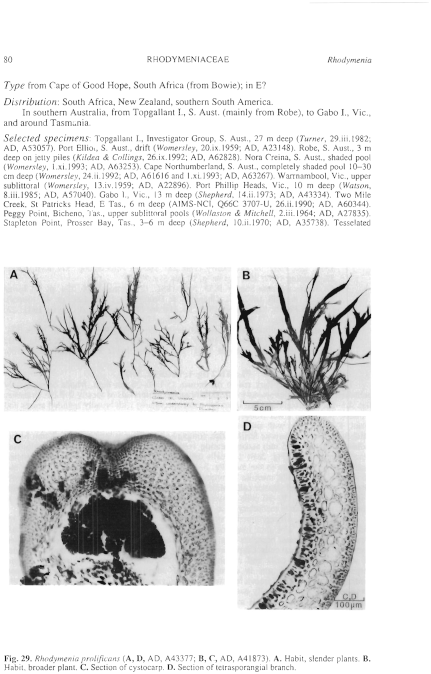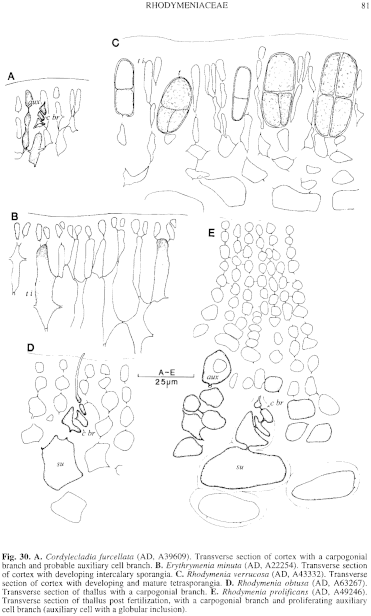|
|
|
|
|
|||||||||||
|
Electronic Flora of South Australia Species Fact Sheet
Phylum Rhodophyta – Class Florideophyceae – Order Rhodymeniales – Family Rhodymeniaceae
Selected citations: Dawson 1941: 138. Guiler 1952: 94. Lucas 1929a: 18. Lucas & Perrin 1947: 201. May 1965: 408. Sonder 1881: 18.
Thallus (Fig. 29A, B) medium to dark red-brown, 5–20 cm high, with numerous, often clumped, fronds from the holdfast, fronds erect, flat, cartilaginous, gradually broadening upwards from the slender stipe to a narrower rounded apex, 0.5–1 mm broad near the base, 2–6 (–8) mm broad near the apices, with frequent proliferous marginal laterals especially from the upper parts, laterals 5–50 mm long, 0.5–4 mm broad, simple or also proliferous from their margins, basally slender and usually broadest near their apices; proliferations also often present on branch surfaces; thallus branches 180–300 (–350) µm thick, stipe terete to compressed, 400–600 µm thick. Holdfast crustose, 2–20 mm across, with few to numerous fronds; epilithic. Structure multiaxial, developing a cortex 3–4 cells thick (Fig. 29D), outer cells ovoid in section and (2–) 3–5 µm in diameter, grading fairly sharply to the medulla (3–) 4–8 cells broad, cells ovoid, 20–45 µm in diameter, stipe medulla becoming 300–450 µm and 12–20 cells broad. Rhodoplasts discoid to elongate.
Reproduction: Gametangial thalli probably dioecious. Carpogonial branches probably 4-celled (Fig. 30E), auxiliary cell branches probably 3-celled, auxiliary cell with a globular inclusion (Fig. 30E). Carposporophytes (Fig. 29C) 270–450 µm across, with erect, branched fusion cells bearing dense masses of ovoid to angular carposporangia 8–14 µm in diameter. Basal nutritive tissue slight, erect filaments soon disintegrating. Cystocarps (Fig. 29C) on the surface (occasionally near margins) of branchlets 400–500 µm thick, medulla 10–15 cells broad, sessile, slightly basally constricted, 0.6–1.2 mm across, pericarp 100–270 µm and 8–20 cells thick, with a depressed ostiole. Spermatangia not observed.
Tetrasporangia (Fig. 29D) in sori near branchlet ends, on one (concave) or both sides, with the cortex slightly extended, cells elongate with small additional outer cells, tetrasporangia ovoid, probably terminal and basally pit-connected only to inner cortical cells, 20–35 µm long and 10–20 µm in diameter, decussately divided.
Type from Georgetown, Tas. (Goodwin); lectotype ("paratype" only seen) in Herb. Zanardini, Museo Civico di Storia Naturale, Venice.
Selected specimens: Lawrence Rock, Portland, Vic., in rock pools (Beauglehole 663, 15.i.1960; AD, A24789). Gabo I., Vic., 1–3 m deep (Shepherd, 15.ii.1973; AD, A43377). Remine, Tas., upper sublittoral pools (Wollaston & Mitchell, 25.ii.1964; AD, A27510). Peggy Point, Bicheno, Tas., upper sublittoral pools (Wollaston & Mitchell, 2.iii.1964; AD, A27830). Safety Cove, Port Arthur, Tas., lower eulittoral (Skinner, 21.ii.1978; AD, A49246). Fluted Cape, Bruny I., Tas., 0–6 m deep (Shepherd, 12.ii.1972; AD, A41873).
Distribution: Lawrence Rock, Portland, Vic., and Gabo I., Vic., and around Tasmania.
Taxonomic notes: R. prolificans is distinctive in habit, with slender branches broadening upwards and numerous marginal and usually also surface proliferations. It is usually found just below low tide level or in pools.
References:
DAWSON, E.Y. (1941). A review of the genus Rhodymenia with descriptions of new species. Allan Hancock Pacif. Exped. 3(7), 115–181.
GUILER, E.R. (1952). The marine algae of Tasmania. Check List with localities. Pap. Proc. R. Soc. Tasm. 86, 71–106.
LUCAS, A.H.S. & PERRIN, F. (1947). The Seaweeds of South Australia. Part 2. The Red Seaweeds. (Govt Printer: Adelaide.)
LUCAS, A.H.S. (1929a). The marine algae of Tasmania. Pap. Proc. R. Soc. Tasm. 1928, 6–27.
MAY, V. (1965). A census and key to the species of Rhodophyceae (red algae) recorded from Australia. Contr. N.S.W. natn. Herb. 3, 349–429.
SONDER, O.W. (1881). In Mueller, F., Fragmenta Phytographiae Australiae. Supplementum ad volumen undecinum: Algae Australianae hactenus cognitae, pp. 1–42, 105–107. (Melbourne.)
ZANARDINI, J. (1874). Phyceae Australicae novae vel minus cognitae. Flora (Regensburg) 57, 486–490, 497–505.
The Marine Benthic Flora of Southern Australia Part IIIB complete list of references.
Publication:
Womersley, H.B.S. (28 June, 1996)
The Marine Benthic Flora of Southern Australia
Rhodophyta. Part IIIB. Gracilarialse, Rhodymeniales, Corallinales and Bonnemaisoniales
Reproduced with permission from The Marine Benthic Flora of Southern Australia Part IIIB 1996, by H.B.S. Womersley. Australian Biological Resources Study, Canberra. Copyright Commonwealth of Australia.
Illustrations in Womersley Part IIIA, 1996: FIGS 29, 30E.

Figure 29 enlarge
Fig. 29. Rhodymenia prolificans (A, D, AD, A43377; B, C, AD, A41873). A. Habit, slender plants. B. Habit, broader plant. C. Section of cystocarp. D. Section of tetrasporangial branch.

Figure 30 enlarge
Fig. 30. A. Cordylecladia furcellata (AD, A39609). Transverse section of cortex with carpogonial branch and probable auxiliary cell branch. B. Erythrymenia minuta (AD, A22254). Transverse section of cortex with developing intercalary sporangia. C. Rhodymenia verrucosa (AD, A43332). Transverse section of cortex with developing and mature tetrasporangia. D. Rhodymenia obtusa (AD, A63267). Transverse section of thallus with a carpogonial branch. E. Rhodymenia prolificans (AD, A49246). Transverse section of thallus post fertilization, with a carpogonial branch and proliferating auxiliary cell branch (auxiliary cell with a globular inclusion).

|
Email Contact: State Herbarium of South Australia |

|